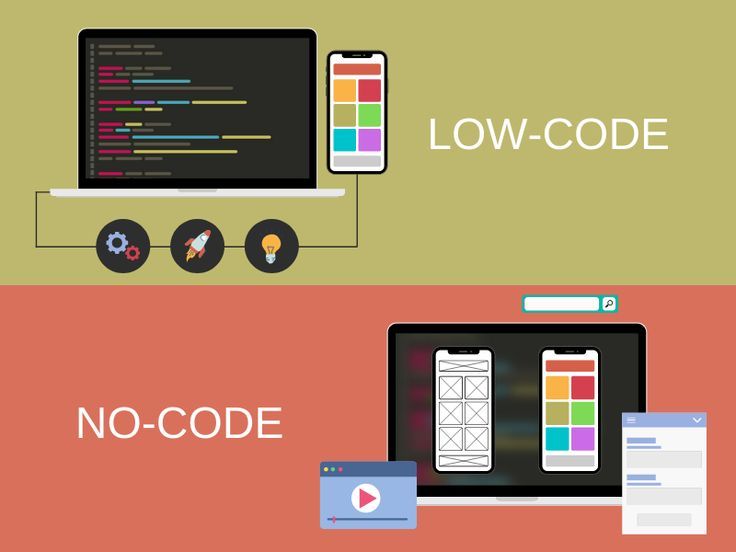Low-code development uses platforms with visual interfaces and pre-built components to speed up app creation, requiring minimal coding. Think of it as a shortcut for developers or tech-savvy users who want flexibility with some coding control. Platforms like OutSystems or Mendix shine here.
No-code development, on the other hand, eliminates coding entirely. With drag-and-drop tools and templates, anyone—yes, even your non-techy aunt—can build apps. Platforms like Bubble, Webflow, and Adalo make it happen.
In 2025, both are booming, with the low-code/no-code market projected to hit $187 billion by 2030, per Statista. But how do they stack up?
How Do Low-Code and No-Code Development Work ?
Both approaches simplify app-building, but their mechanics differ:
- Low-Code: Offers visual builders (like drag-and-drop interfaces) plus the option to add custom code. Developers use it to create complex apps faster, integrating with APIs or databases. It’s like cooking with a recipe but tweaking the spices.
- No-Code: Relies entirely on visual tools, pre-built widgets, and automation. Users design apps by arranging elements like forms or buttons, no coding needed. It’s like assembling a meal kit—everything’s ready to go.
For example, a low-code platform like Microsoft Power Apps might let a developer build a custom CRM with some Python tweaks, while a no-code tool like Glide lets a marketer create a customer portal in hours.
Key Differences Between Low-Code and No-Code Development
| Aspect | Low-Code | No-Code |
|---|---|---|
| Skill Level | Basic coding knowledge helpful | No coding skills required |
| Complexity | Handles complex, enterprise-grade apps | Best for simple to moderately complex apps |
| Customization | High, with custom code options | Limited to platform features |
| Speed | Fast, but slower than no-code | Lightning-fast for quick builds |
| Target Users | Developers, IT teams, tech-savvy users | Business owners, marketers, beginners |
A 2024 Gartner report predicts 80% of apps will be built with low-code/no-code by 2026, showing their massive impact.

Applications of Low-Code vs No-Code Development
Low-Code Use Cases
- Enterprise Solutions: Large companies use low-code platforms like ServiceNow to build HR systems or supply chain tools, integrating with existing databases. A bank might create a loan processing app in weeks, not months.
- Custom Apps: Developers use OutSystems to build tailored solutions, like inventory trackers with unique logic, cutting development time by 50%, per Forrester.
- Legacy Modernization: Low-code helps update old systems, like migrating a 90s database to a modern app, without a full rewrite.
No-Code Use Cases
- Startups: Entrepreneurs use Bubble to launch MVPs (minimum viable products) like e-commerce platforms or booking apps, testing ideas without spending $50,000 on developers.
- Small Businesses: A café owner might use Glide to create a loyalty app, boosting customer retention by 20%, per HubSpot.
- Automation: No-code tools like Zapier automate workflows, like syncing customer data between Mailchimp and Airtable, saving hours weekly.
Benefits of Low-Code vs No-Code Development
Low-Code Benefits
- Flexibility: Add custom code for unique features, like advanced analytics or IoT integration.
- Scalability: Handles large-scale apps for thousands of users, ideal for enterprises.
- Speed: Cuts development time by up to 70% compared to traditional coding, per Deloitte.
No-Code Benefits
- Accessibility: Anyone can build apps, no tech degree needed.
- Speed: Create apps in hours or days, perfect for rapid prototyping.
- Cost-Effective: Reduces costs by avoiding developer fees, saving thousands.
Low-Code vs No-Code: Which Should You Choose ?
- Choose Low-Code if you’re a developer or business needing complex, scalable apps with custom features. Ideal for enterprises or projects requiring deep integrations.
- Choose No-Code if you’re a beginner, startup, or small business wanting quick, affordable apps without coding. Perfect for MVPs or simple tools.
Test both with free trials—try OutSystems for low-code or Bubble for no-code. Your choice depends on your skills, budget, and project goals.
Why Low-Code vs No-Code Development Matters
Low-code and no-code development are democratizing tech, letting everyone from startups to teachers create apps that solve real problems. They’re not just tools—they’re a movement, empowering ideas without barriers. Whether you’re building the next Uber or a team dashboard, low-code/no-code puts the power in your hands.
So are ya ready to create ? Explore platforms like Webflow or Microsoft Power Apps, join no-code communities on X, or watch YouTube tutorials to get started. With low-code vs no-code development, your big idea is just a click away !
